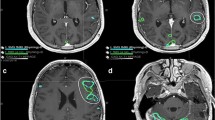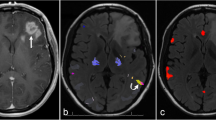Abstract
Introduction
Functional MRI (fMRI) can assess language lateralization in brain tumor patients; however, this can be limited if the primary language area—Broca’s area (BA)—is affected by the tumor. We hypothesized that the middle frontal gyrus (MFG) can be used as a clinical indicator of hemispheric dominance for language during presurgical workup.
Methods
Fifty-two right-handed subjects with solitary left-hemispheric primary brain tumors were retrospectively studied. Subjects performed a verbal fluency task during fMRI. The MFG was compared to BA for fMRI voxel activation, language laterality index (LI), and the effect of tumor grade on the LI.
Results
Language fMRI (verbal fluency) activated more voxels in MFG than in BA (MFG = 315, BA = 216, p < 0.001). Voxel activations in the left-hemispheric MFG and BA were positively correlated (r = 0.69, p < 0.001). Mean LI in the MFG was comparable to that in BA (MFG = 0.48, BA = 0.39, p = 0.06). LIs in MFG and BA were positively correlated (r = 0.62, p < 0.001). Subjects with high-grade tumors demonstrate lower language lateralization than those with low-grade tumors in both BA and MFG (p = 0.02, p = 0.02, respectively).
Conclusion
MFG is comparable to BA in its ability to indicate hemispheric dominance for language using a measure of verbal fluency and may be an adjunct measure in the clinical determination of language laterality for presurgical planning.




Similar content being viewed by others
Abbreviations
- BA:
-
Broca’s area
- LI:
-
Laterality index
- MFG:
-
Middle frontal gyrus
- ROI:
-
Region of interest
- DCS:
-
Direct cortical stimulation
References
Sunaert S (2006) Presurgical planning for tumor resectioning. J Magn Reson Imaging 23:887–905. doi:10.1002/jmri.20582
Vlieger E-J, Majoie CB, Leenstra S, den Heeten GJ (2004) Functional magnetic resonance imaging for neurosurgical planning in neurooncology. Eur Radiol 14:1143–1153. doi:10.1007/s00330-004-2328-y
Janecek JK, Swanson SJ, Sabsevitz DS et al (2013) Language lateralization by fMRI and Wada testing in 229 patients with epilepsy: rates and predictors of discordance. Epilepsia 54:314–322. doi:10.1111/epi.12068
Dym RJ, Burns J, Freeman K, Lipton ML (2011) Is functional MR imaging assessment of hemispheric language dominance as good as the Wada test?: a meta-analysis. Radiology 261:446–455. doi:10.1148/radiol.11101344
Desmond JE, Sum JM, Wagner AD et al (1995) Functional MRI measurement of language lateralization in Wada-tested patients. Brain 118:1411–1419. doi:10.1093/brain/118.6.1411
Lehéricy S, Cohen L, Bazin B et al (2000) Functional MR evaluation of temporal and frontal language dominance compared with the Wada test. Neurology 54:1625–1633. doi:10.1212/WNL.54.8.1625
Ulmer JL, Hacein-Bey L, Mathews VP et al (2004) Lesion-induced pseudo-dominance at functional magnetic resonance imaging: implications for preoperative assessments. Neurosurgery 55:569–579, discussion 580–581
Hou BL, Bradbury M, Peck KK et al (2006) Effect of brain tumor neovasculature defined by rCBV on BOLD fMRI activation volume in the primary motor cortex. Neuroimage 32:489–497. doi:10.1016/j.neuroimage.2006.04.188
Szaflarski JP, Binder JR, Possing ET et al (2002) Language lateralization in left-handed and ambidextrous people fMRI data. Neurology 59:238–244. doi:10.1212/WNL.59.2.238
Frost JA, Binder JR, Springer JA et al (1999) Language processing is strongly left lateralized in both sexes. Brain 122:199–208. doi:10.1093/brain/122.2.199
Sanai N, Mirzadeh Z, Berger MS (2008) Functional outcome after language mapping for glioma resection. N Engl J Med 358:18–27
Brown S, Martinez MJ, Parsons LM (2006) Music and language side by side in the brain: a PET study of the generation of melodies and sentences. Eur J Neurosci 23:2791–2803. doi:10.1111/j.1460-9568.2006.04785.x
Wang S, Zhu Z, Zhang JX et al (2008) Broca’s area plays a role in syntactic processing during Chinese reading comprehension. Neuropsychologia 46:1371–1378. doi:10.1016/j.neuropsychologia.2007.12.020
Abrahams S, Goldstein LH, Simmons A et al (2003) Functional magnetic resonance imaging of verbal fluency and confrontation naming using compressed image acquisition to permit overt responses. Hum Brain Mapp 20:29–40. doi:10.1002/hbm.10126
Leung H-C, Gore JC, Goldman-Rakic PS (2002) Sustained mnemonic response in the human middle frontal gyrus during on-line storage of spatial memoranda. J Cogn Neurosci 14:659–671. doi:10.1162/08989290260045882
Acheson DJ, MacDonald MC (2009) Verbal working memory and language production: common approaches to the serial ordering of verbal information. Psychol Bull 135:50–68. doi:10.1037/a0014411
Baddeley A (2003) Working memory and language: an overview. J Commun Disord 36:189–208. doi:10.1016/S0021-9924(03)00019-4
Smolker HR, Depue BE, Reineberg AE et al (2015) Individual differences in regional prefrontal gray matter morphometry and fractional anisotropy are associated with different constructs of executive function. Brain Struct Funct 220:1291–1306. doi:10.1007/s00429-014-0723-y
Steinmann E, Schmalor A, Prehn-Kristensen A et al (2014) Developmental changes of neuronal networks associated with strategic social decision-making. Neuropsychologia 56:37–46. doi:10.1016/j.neuropsychologia.2013.12.025
Roux F-E, Boulanouar K, Lotterie J-A et al (2003) Language functional magnetic resonance imaging in preoperative assessment of language areas: correlation with direct cortical stimulation. Neurosurgery 52:1335–1347. doi:10.1227/01.NEU.0000064803.05077.40
Kamada K, Sawamura Y, Takeuchi F et al (2007) Expressive and receptive language areas determined by a non-invasive reliable method using functional magnetic resonance imaging and magnetoencephalography. Neurosurgery 60:296–305. doi:10.1227/01.NEU.0000249262.03451.0E
Veale JF (2014) Edinburgh handedness inventory—short form: a revised version based on confirmatory factor analysis. Laterality Asymmetr Body Brain Cogn 19:164–177. doi:10.1080/1357650X.2013.783045
Benton AL, Hamsher KD, Sivan AB (1994) Multilingual aphasia examination: manual of instructions. AJA Assoc, Iowa City
Partovi S, Jacobi B, Rapps N et al (2012) Clinical standardized fMRI reveals altered language lateralization in patients with brain tumor. Am J Neuroradiol 33:2151–2157. doi:10.3174/ajnr.A3137
Stippich C, Rapps N, Dreyhaupt J et al (2007) Localizing and lateralizing language in patients with brain tumors: feasibility of routine preoperative functional MR imaging in 81 consecutive patients. Radiology 243:828–836. doi:10.1148/radiol.2433060068
Bandettini PA, Jesmanowicz A, Wong EC, Hyde JS (1993) Processing strategies for time-course data sets in functional MRI of the human brain. Magn Reson Med 30:161–173
Haupage S, Peck KK, Branski RC et al (2010) Functional MRI of tongue motor tasks in patients with tongue cancer: observations before and after partial glossectomy. Neuroradiology 52:1185–1191. doi:10.1007/s00234-010-0748-8
Binder JR, Swanson SJ, Hammeke TA et al (1996) Determination of language dominance using functional MRI a comparison with the Wada test. Neurology 46:978–984. doi:10.1212/WNL.46.4.978
Seghier ML (2008) Laterality index in functional MRI: methodological issues. Magn Reson Imaging 26:594–601. doi:10.1016/j.mri.2007.10.010
Deblaere K, Boon PA, Vandemaele P et al (2004) MRI language dominance assessment in epilepsy patients at 1.0 T: region of interest analysis and comparison with intracarotid amytal testing. Neuroradiology 46:413–420. doi:10.1007/s00234-004-1196-0
Springer JA, Binder JR, Hammeke TA et al (1999) Language dominance in neurologically normal and epilepsy subjects a functional MRI study. Brain 122:2033–2046. doi:10.1093/brain/122.11.2033
Rogalski E, Cobia D, Harrison TM et al (2011) Anatomy of language impairments in primary progressive aphasia. J Neurosci Off J Soc Neurosci 31:3344–3350. doi:10.1523/JNEUROSCI.5544-10.2011
Fertonani A, Rosini S, Cotelli M et al (2010) Naming facilitation induced by transcranial direct current stimulation. Behav Brain Res 208:311–318. doi:10.1016/j.bbr.2009.10.030
Grossman M, Cooke A, DeVita C et al (2002) Age-related changes in working memory during sentence comprehension: an fMRI study. Neuroimage 15:302–317. doi:10.1006/nimg.2001.0971
Adcock J, Wise R, Oxbury J et al (2003) Quantitative fMRI assessment of the differences in lateralization of language-related brain activation in patients with temporal lobe epilepsy. Neuroimage 18:423–438. doi:10.1016/S1053-8119(02)00013-7
Wong SWH, Jong L, Bandur D et al (2009) Cortical reorganization following anterior temporal lobectomy in patients with temporal lobe epilepsy. Neurology 73:518–525. doi:10.1212/WNL.0b013e3181b2a48e
Holodny AI, Schulder M, Liu W-C et al (2000) The effect of brain tumors on BOLD functional MR imaging activation in the adjacent motor cortex: implications for image-guided neurosurgery. Am J Neuroradiol 21:1415–1422
Schreiber A, Hubbe U, Ziyeh S, Hennig J (2000) The influence of gliomas and nonglial space-occupying lesions on blood-oxygen-level–dependent contrast enhancement. Am J Neuroradiol 21:1055–1063
Ulmer JL, Krouwer HG, Mueller WM et al (2003) Pseudo-reorganization of language cortical function at fMR imaging: a consequence of tumor-induced neurovascular uncoupling. Am J Neuroradiol 24:213–217
Brannen JH, Badie B, Moritz CH et al (2001) Reliability of functional MR imaging with word-generation tasks for mapping Broca’s area. Am J Neuroradiol 22:1711–1718
Zacà D, Jarso S, Pillai JJ (2013) Role of semantic paradigms for optimization of language mapping in clinical fMRI studies. Am J Neuroradiol 34:1966–1971. doi:10.3174/ajnr.A3628
Zacà D, Nickerson JP, Deib G, Pillai JJ (2012) Effectiveness of four different clinical fMRI paradigms for preoperative regional determination of language lateralization in patients with brain tumors. Neuroradiology 54:1015–1025. doi:10.1007/s00234-012-1056-2
Pillai JJ, Zaca D (2011) Relative utility for hemispheric lateralization of different clinical fMRI activation tasks within a comprehensive language paradigm battery in brain tumor patients as assessed by both threshold-dependent and threshold-independent analysis methods. Neuroimage 54(Suppl 1):S136–145. doi:10.1016/j.neuroimage.2010.03.082
FitzGerald DB, Cosgrove GR, Ronner S et al (1997) Location of language in the cortex: a comparison between functional MR imaging and electrocortical stimulation. Am J Neuroradiol 18:1529–1539
Knecht S, Drager B, Bobe L et al (2000) Handedness and hemispheric language dominance in healthy humans. Brain 123:2512–2518
Vikingstad EM, George KP, Johnson AF, Cao Y (2000) Cortical language lateralization in right handed normal subjects using functional magnetic resonance imaging. J Neurol Sci 175:17–27. doi:10.1016/S0022-510X(00)00269-0
Orellana CM, Visch-Brink E, Vernooij M et al (2015) Crossed cerebrocerebellar language lateralization: an additional diagnostic feature for assessing atypical language representation in presurgical functional MR imaging. Am J Neuroradiol 36:518–524. doi:10.3174/ajnr.A4147
Author information
Authors and Affiliations
Corresponding author
Ethics declarations
We declare that all human and animal studies have been approved by the Institutional Review Board and have therefore been performed in accordance with the ethical standards laid down in the 1964 Declaration of Helsinki and its later amendments. We declare that all patients gave informed consent prior to inclusion in this study.
Conflict of interest
We declare that we have no conflict of interest.
Electronic supplementary material
Below is the link to the electronic supplementary material.
ESM 1
(DOCX 112 kb)
Rights and permissions
About this article
Cite this article
Dong, J.W., Brennan, N.M.P., Izzo, G. et al. fMRI activation in the middle frontal gyrus as an indicator of hemispheric dominance for language in brain tumor patients: a comparison with Broca’s area. Neuroradiology 58, 513–520 (2016). https://doi.org/10.1007/s00234-016-1655-4
Received:
Accepted:
Published:
Issue Date:
DOI: https://doi.org/10.1007/s00234-016-1655-4




